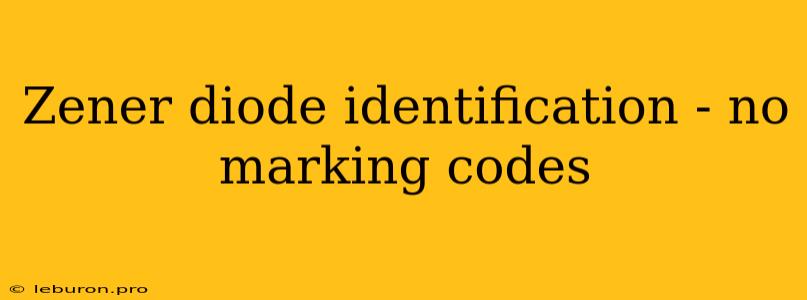Identifying a Zener diode without any marking codes can be a challenging task, but with the right tools and techniques, it is possible to determine its characteristics. Zener diodes are essential components in electronic circuits, acting as voltage regulators and providing a stable voltage reference. When a Zener diode lacks markings, it becomes necessary to rely on other methods to identify its properties, including its breakdown voltage and power dissipation. This article will explore various strategies and techniques to identify an unmarked Zener diode, offering insights for electronics enthusiasts and professionals alike.
Visual Inspection and Physical Characteristics
The first step in identifying an unmarked Zener diode is a thorough visual inspection. This involves examining its physical characteristics, which can provide initial clues about its type and function.
Size and Shape
Zener diodes come in various sizes and shapes, and their physical dimensions can offer some indication about their voltage rating. Larger diodes typically have higher power dissipation capabilities and might be associated with higher voltage ratings.
Color Coding
Some Zener diodes may have color bands or stripes on their body. These color codes can be helpful in identifying the diode's voltage rating. However, the color codes can vary between manufacturers, so it's important to consult datasheets or online resources for specific interpretations.
Electrical Testing Techniques
To determine the Zener diode's characteristics, electrical testing is crucial. This section explores several methods commonly employed to identify unmarked Zener diodes.
Using a Multimeter
A multimeter is an indispensable tool for identifying unmarked Zener diodes. By measuring the diode's forward and reverse voltage characteristics, you can gain insights into its breakdown voltage.
Forward Voltage Measurement
In forward bias, a Zener diode behaves like a regular diode. The forward voltage drop across the diode should be approximately 0.7 volts. By connecting the positive lead of the multimeter to the anode and the negative lead to the cathode, measure the voltage drop across the diode. The reading should be around 0.7 volts if the diode is working properly.
Reverse Breakdown Voltage Measurement
The reverse breakdown voltage is the critical parameter of a Zener diode. To measure it, connect the positive lead of the multimeter to the cathode and the negative lead to the anode. Gradually increase the voltage applied to the diode. At a specific voltage level, the diode will enter the breakdown region, and the voltage across it will stabilize. This voltage represents the Zener breakdown voltage.
Using a Variable Power Supply
A variable power supply allows for more controlled voltage application to the Zener diode. By slowly increasing the voltage across the diode, you can observe the point at which it enters breakdown.
Identifying the Breakdown Voltage
As you raise the voltage applied to the Zener diode, the current through it will increase gradually. At the breakdown voltage, the current will rise sharply while the voltage across the diode remains almost constant. This characteristic behavior helps identify the breakdown voltage.
Calculating Power Dissipation
Once you know the breakdown voltage and the current at the breakdown point, you can calculate the power dissipation of the diode. The power dissipation (P) is calculated using the formula:
P = V * I
where:
- V = Breakdown voltage
- I = Current at breakdown
Using a Function Generator and Oscilloscope
For more precise measurements, a function generator and oscilloscope can be employed. The function generator provides a variable-frequency signal, and the oscilloscope displays the voltage waveform across the diode.
Visualizing the Breakdown Point
When a sinusoidal waveform is applied to the Zener diode, the oscilloscope displays the voltage across the diode. As the voltage rises above the breakdown voltage, the diode enters the breakdown region, and the waveform becomes clipped. By analyzing the waveform, you can determine the breakdown voltage.
Safety Precautions and Considerations
When testing Zener diodes, it is crucial to take appropriate safety precautions.
- Using a Current Limiting Resistor: It's essential to use a current-limiting resistor in series with the Zener diode to prevent excessive current flow and potential damage to the diode.
- Avoid Excessive Voltage: Applying a voltage higher than the Zener diode's breakdown voltage can permanently damage the diode.
- Proper Grounding: Ensure that the circuit is properly grounded to minimize the risk of electrical shock.
- Discharging Capacitors: Before handling any components in the circuit, always discharge any capacitors to prevent electrical shocks.
Conclusion
Identifying unmarked Zener diodes can be a challenging yet achievable task. Utilizing various electrical testing techniques, such as multimeter measurements, variable power supply tests, and function generator/oscilloscope analysis, you can determine the breakdown voltage and power dissipation of an unmarked Zener diode. By employing these methods and taking appropriate safety precautions, electronics enthusiasts and professionals can gain valuable insights into the characteristics of unmarked Zener diodes, facilitating their use in circuit designs and repair projects. Remember that the success of these techniques depends on the quality of the test equipment and the careful implementation of the procedures.
